AUDI S7 2013 Owners Manual
Manufacturer: AUDI, Model Year: 2013, Model line: S7, Model: AUDI S7 2013Pages: 310, PDF Size: 77.45 MB
Page 261 of 310
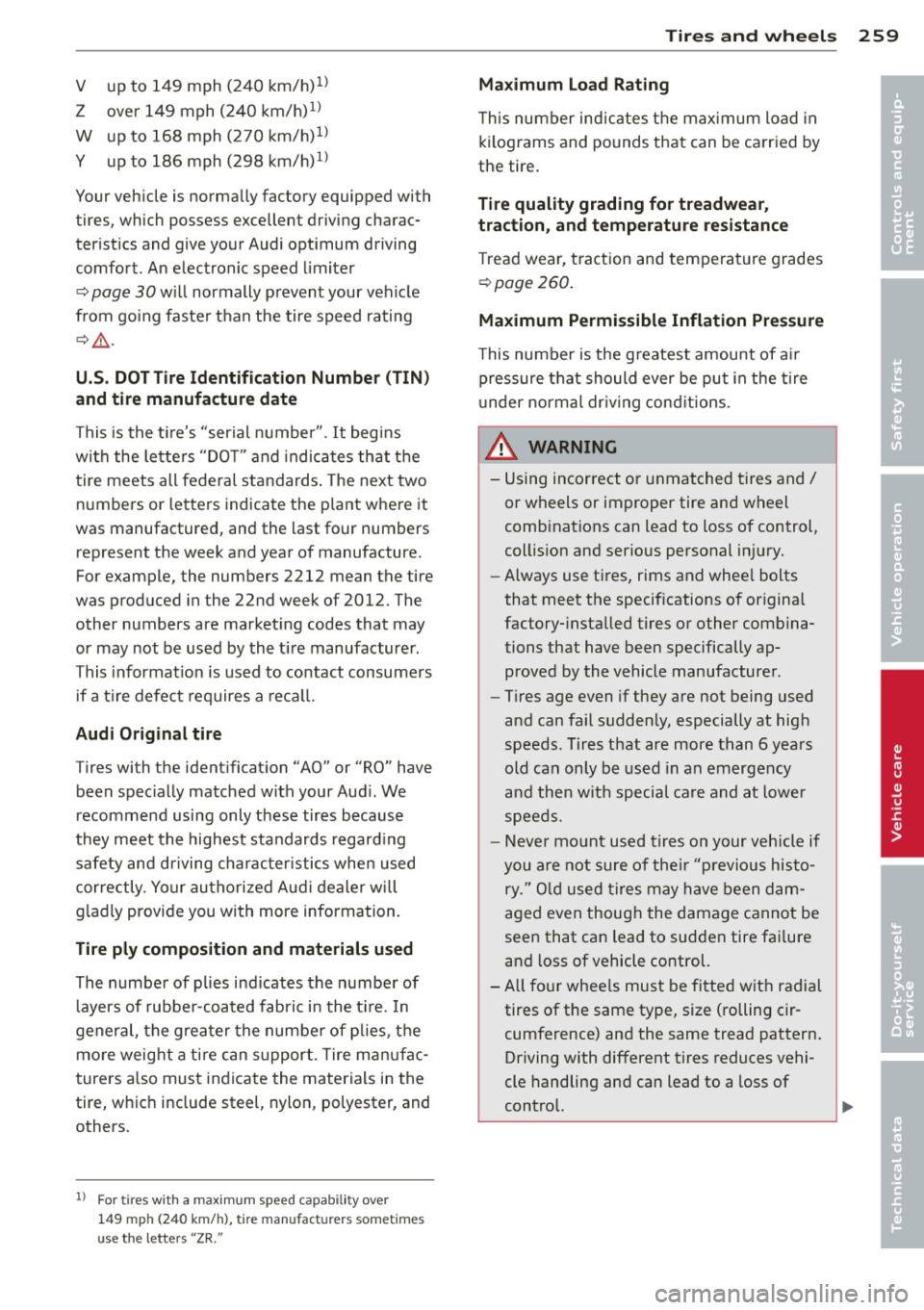
V up to 149 mph (240 km/h)1
)
Z over 149 mph (240 km/h)1)
W up to 168 mph (270 km/h)1l
Y up to 186 mph (298 km/h)
1 )
Your veh icle is norma lly factory equipped with
t ires, which posses s excellen t driving charac
ter istics and give your Audi opt imum driving
comfort . An electronic speed limiter
~ page 30 w ill normally prevent your vehicle
from go ing faste r th an the tire speed rating
~ &. -
U.S. DOT T ire Identification Number (TIN )
and tire manufactur e date
This is the t ire's "serial numbe r" . It begins
with the le tters "DOT" and indicates that the
tire meets all federal standards . The next two
numbers or letters indicate the p lant where it
was manufactured, and the last four numbers represent the week and year of manufactu re.
Fo r example, the numbers 2212 mean the tire
was produced in the 22nd week of 2012. The
other numbers are market ing codes that may
or may not be used by the t ire manufacturer.
This informat ion is used to contact consumers
if a t ire defect requires a reca ll.
Aud i Original tire
Tires with the iden tifica tion "AO" or "RO" have
been spec ially matched with your Aud i. We
recommend using only these tires because
they meet the highest standards regard ing
safety and d riving charac ter istics when used
correctly . Yo ur au thori zed Audi dealer w ill
g lad ly provide you with more information.
Tire ply composition and materials used
The numbe r of p lies ind icates the n umber of
l ayers of rubber-coated fabric i n the t ire. In
gener al, the grea ter the numbe r of p lies, the
more weig ht a tire can s upport. Tire man ufac
turers a lso must indicate the materials in the
tire, wh ich include ste el, nylon, polyest er, and
others.
ll Fo r tires wit h a m ax im um s pee d ca pabil ity over
1 4 9 m ph (24 0 k m/h) , tire m an ufa ctur ers somet ime s
use the let ters "ZR."
Tire s an d wheel s 259
Maximum Load Rating
This number indicates the max imum load in
k ilograms and po unds t hat can be ca rr ied by
the tire.
Tire quality grading for treadwear ,
traction, and temp eratu re resistance
T read wear, t raction and tempe ra tu re grades
¢ page
260 .
Maximum Permissible Inflation Pressure
This number is the greatest amount of a ir
pressure that should ever be put in the tire
u nder norma l dr iv ing cond itions .
_& WARNING ~
- Using incorrect o r unmatched tires and I
or wheels or improper tire and wheel
comb inat ions can lead to loss of control,
coll is ion and serious personal in jury.
- Always use t ires , rims and whee l bolts
that meet the specif ications of original
factory- installed tires or other combina
tions that have been sp ecifically ap
proved by the vehicle manufacture r.
- Tires age even if they are not being used
and can fai l sudden ly, especially at high
speeds . Tires that are more than 6 yea rs
old can only be used in an emergency
and then w ith special care and at lower
speeds.
- Never mo unt used tires on your veh icle if
you are not sure of the ir "previous histo
ry ." O ld used tires may have been dam
aged even though the damage cannot be
seen that can lead to sudden tire fai lure
and loss of vehicle control.
-All four whee ls must be fitted with radial
tires of the same type, size (rolling cir cumference) and the same tread pattern .
Driving with different tires reduces vehi
cle handling and can lead to a loss of
control.
•
•
Page 262 of 310
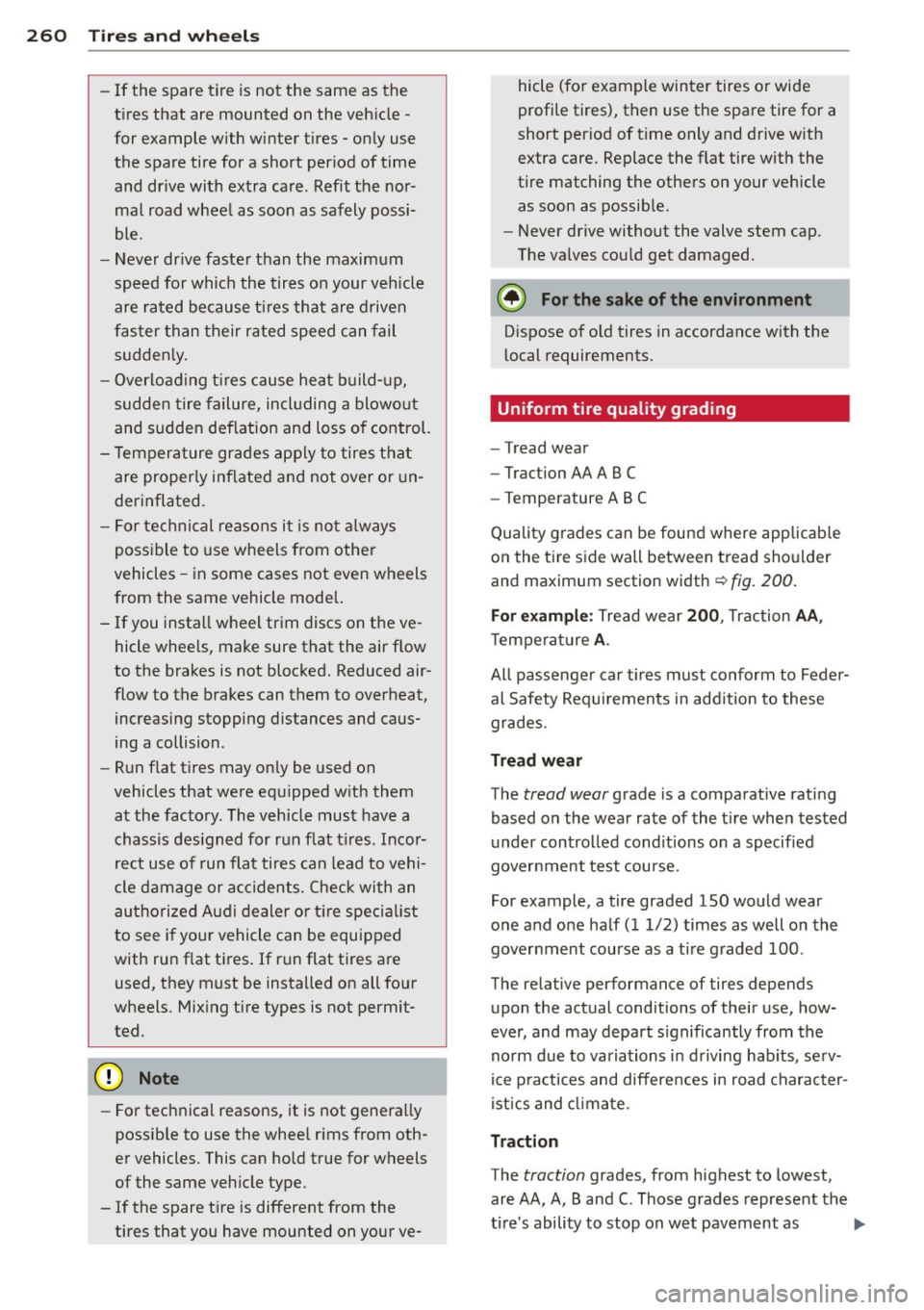
260 Tires and wheels
-If the spare tire is not the same as the
tires that are mounted on the vehicle -
for example with winter tires - only use
the spare tire for a short period of time and drive with extra care. Refit the nor
mal road wheel as soon as safely possi
ble.
- Never drive faster than the maximum
speed for which the tires on your vehicle
are rated because tires that are driven
faster than their rated speed can fail
suddenly.
- Overloading tires cause heat build-up,
sudden tire failure, including a blowout
and sudden deflation and loss of control.
- Temperature grades apply to tires that
are properly inflated and not over or un
derinflated.
- For technical reasons it is not always
possible to use wheels from other
vehicles -in some cases not even wheels
from the same vehicle model.
- If you install wheel trim discs on the ve
hicle wheels, make sure that the air flow
to the brakes is not blocked. Reduced air
flow to the brakes can them to overheat,
increasing stopping distances and caus
ing a collision.
- Run flat tires may only be used on
vehicles that were equipped with them
at the factory. The vehicle must have a
chassis designed for run flat tires. Incor
rect use of run flat tires can lead to vehi
cle damage or accidents. Check with an
authorized Audi dealer or tire specialist
to see if your vehicle can be equipped
with run flat tires. If run flat tires are
used, they must be installed on all four
wheels. Mixing tire types is not permit
ted.
- For technical reasons, it is not generally
possible to use the wheel rims from oth
er vehicles. This can hold true for wheels
of the same vehicle type.
- If the spare tire is different from the
tires that you have mounted on your ve- hicle (for example winter tires or wide
profile tires), then use the spare tire for a
short period of time only and drive with
extra care. Replace
the flat tire with the
tire matching the others on your vehicle
as soon as possible.
- Never drive without the valve stem cap.
The valves could get damaged.
@ For the sake of the environment
Dispose of old tires in accordance with the
local requirements.
Uniform tire quality grading
-Tread wear
- Traction AA A B C
- Temperature ABC
Quality grades can be found where applicable
on the tire side wall between tread shoulder
and maximum section width
~ fig. 200.
For example: Tread wear 200, Traction AA,
Temperature A.
All passenger car tires must conform to Feder
al Safety Requirements in addition to these
grades .
Tread wear
The tread wear grade is a comparative rating
based on the wear rate of the tire when tested
under controlled conditions on a specified
government test course.
Fo r example, a tire graded 150 would wear
one and one half (1 1/2) times as well on the
government course as a tire graded 100.
The relative performance of tires depends
upon the actual conditions of their use, how
ever, and may depart significantly from the
norm due to variations in driving habits, serv
ice practices and differences in road character
istics and climate.
Traction
The traction grades, from highest to lowest,
are AA, A, Band
C. Those grades represent the
tire's ability to stop on wet pavement as ..,.
Page 263 of 310
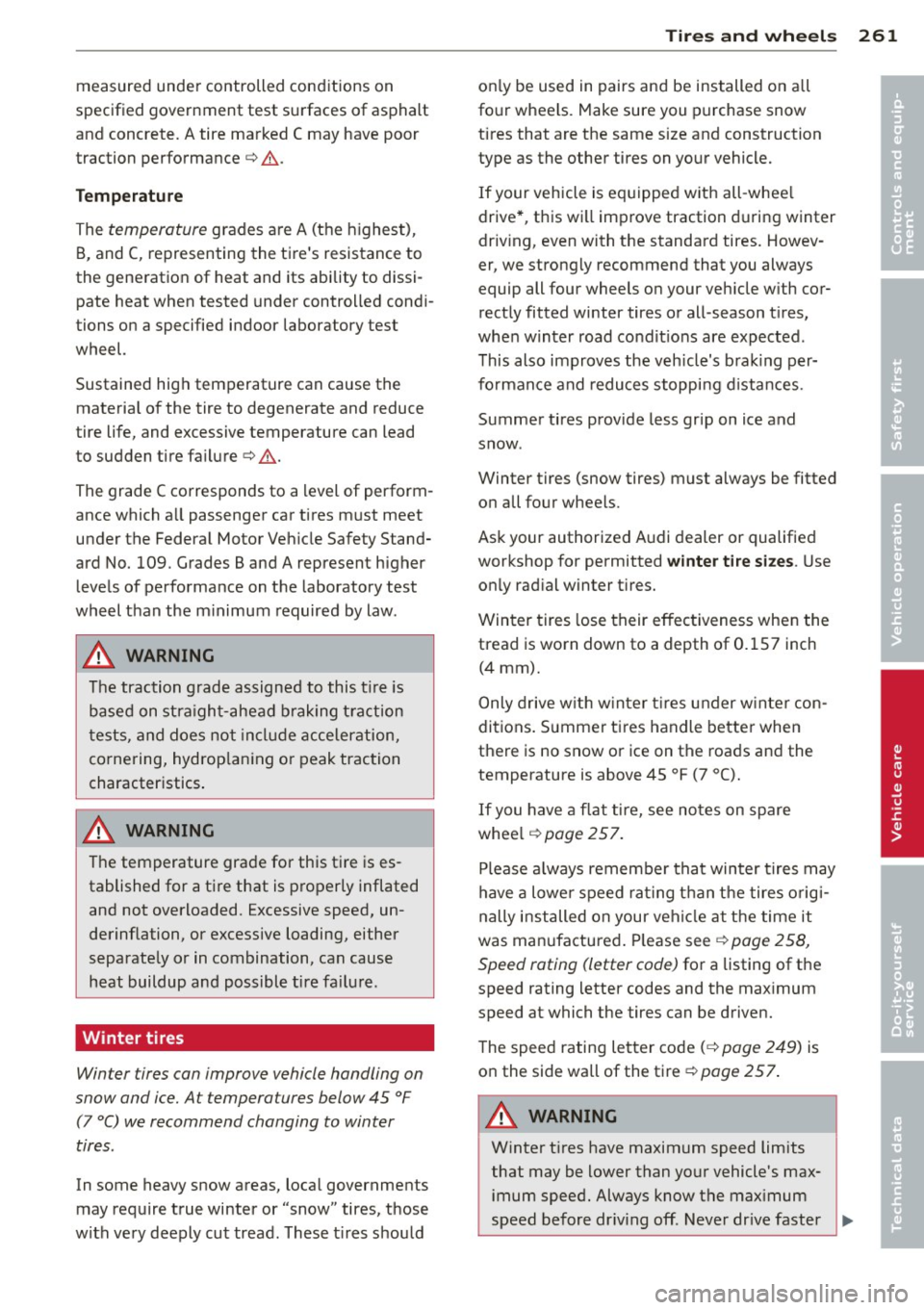
measured under controlled conditions on
specified government test surfaces of asphalt
and concrete. A tire marked C may have poor
traction performance
c::> & .
Temp erature
The temperature grades a re A (the highest),
B, and C , representing the tire's resistance to
the generation of heat and its ability to dissi pate heat when tested under controlled condi
tions on a specified indoor laboratory test
wheel.
Sustained high temperature can cause the materia l of the tire to degenerate and reduce
tire life, and excessive temperature can lead
to sudden tire fa ilure
c::> & .
The grade C corresponds to a level of perform
ance which a ll passenger car tires must meet
under the Federal Motor Veh icle Safety Stand
ard No.
109. Grades Band A represent higher
levels of performance on the laboratory test
wheel than the m inimum required by law .
&, WARNING
The traction grade assigned to this t ire is
based on stra ight-ahead b raking traction
tests, and does not include acceleration,
cornering, hydrop laning or peak traction
character istics .
A WARNING
The temperature grade for this tire is es
tablished for a tire that is properly inflated
and not overloaded . Excessive speed, un
derinflation, or excessive loading, either
separate ly or in combination, can cause
heat buildup and possible tire fa ilure.
Winter tires
Win ter tires can improve vehicle handling on
snow and ice. At tempera tures below 45 °F
(7 °C) we recommend changing to winter
tires.
In some heavy snow areas, loca l governments
may require true winter or "snow" tires, those
with very deeply cut tread. These t ires should
Tire s an d wheel s 261
only be used in pairs and be installed on all
fo ur wheels. Make sure you purchase snow
tires that are the same size and construction
type as the other tires on your vehicle.
If your vehicle is eq uipped w ith all -whee l
drive*, this wi ll improve traction during winter
driv ing, even with the standard tires. Howev
er, we strongly recommend that you always equip all four wheels on your veh icle w ith cor
rectly fitted winter tires or all -season t ires,
whe n w inter road cond it ions are expected.
T his also improves the veh icle's brak ing per
fo rmance and reduces stoppi ng d istances.
Summer tires provide less grip on ice and
snow .
Winter tires (snow tires) must always be fitted
on all four wheels.
Ask your authorized A udi dealer or qualified
workshop for permitted
wi nter ti re size s. Use
on ly rad ial winter t ires.
Winter tires lose their effectiveness when the
tread is worn down to a depth of
0 .1 57 inch
(4 mm).
Only drive w ith w inter tires under w inter con
ditions. S umme r tires handle better when
there is no snow or ice on the roads and the
temperature is above 45
°F (7 ° ().
If you have a flat tire, see no tes on spare
whee l c::> page 257.
Please a lways remember that winter tires may
have a lowe r speed ra ting than the tires o rig i
nally installed on your veh icle at the time it
was man ufactured. P lease see
c::> pag e 258,
Speed rating (letter code) for a listing of the
speed rating letter codes and the max imum
speed at which the tires can be driven.
The speed rating le tter code
(c::> page 249) is
on the side wall of the tire
c::> page 257.
A WARNING
Winter t ires have maximum speed limits
that may be lower than yo ur vehicle's max
imum speed. Always know the max imum
speed before dr iv ing off . Never dr ive faster
~
•
•
Page 264 of 310
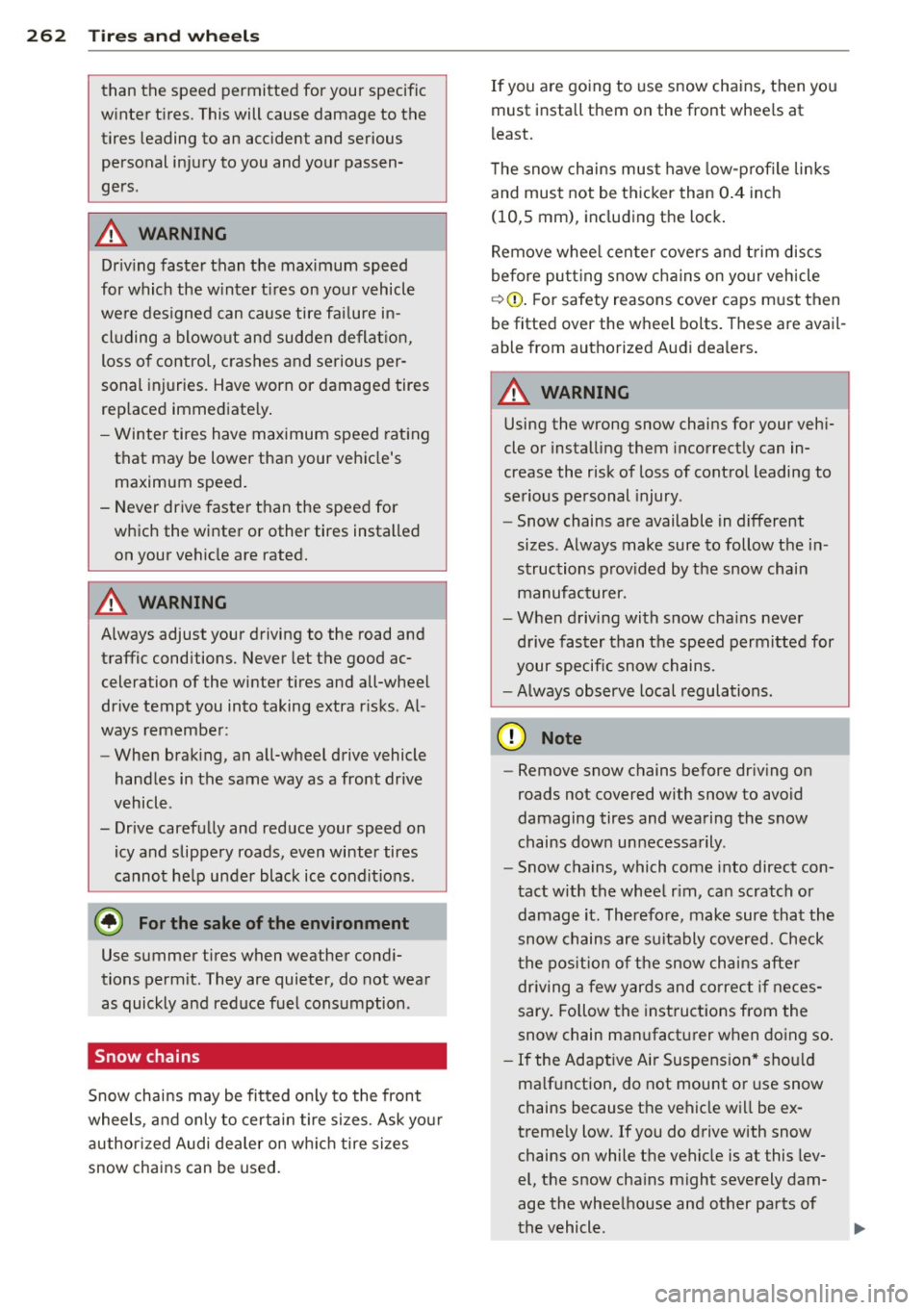
26 2 T ire s and wheel s
than the speed permitted for your specific
w inter t ires. This will cause damage to the
tires leading to an accident and serious
personal injury to you and your passen
gers .
A WARNING
Driv ing faster than the maximum speed
for which the w inter t ires on your vehicle
we re designed can cause tire fai lu re in
cluding a blowout and sudden deflat ion,
loss of control, crashes and serious per
sonal injuries. Have worn or damaged tires
rep laced immediate ly .
- Winter tires have maximum speed rat ing
that may be lower than your veh icle's
maximum speed.
- Never drive faster than the speed for
which the winter or other tires installed
on your vehicle are rated.
A WARNING
Always adjust your driving to the road and
traffic conditions. Never let the good ac
celeration of the winter tires and all-whee l
drive tempt you into taking extra r isks. A l
ways remember :
- When brak ing, an all-w heel drive vehicle
hand les in the same way as a front drive
vehicle .
- Drive carefu lly and reduce your speed on
icy and slippery roads, even winter tires
cannot he lp under black ice condit ions .
@ For the sake of the environment
Use summer tires when weather cond i
tions permit . They are quieter, do not wea r
as quickly and reduce f ue l consumption .
Snow chains
-
Snow chains may be fitted on ly to the front
wheels, and only to certa in tire sizes. Ask yo ur
author ized Audi dealer on wh ic h tire sizes
snow chains can be used.
If you are going to use snow chains, then you
must i nstall them on the front whee ls at
l east.
T he snow chains mus t have low-p rofile links
and must not be th icker than 0 .4 inch
(10,5 mm) , includ ing the lock .
Remove whee l cen ter covers and t rim discs
before pu tting snow c hains on your veh icle
¢ (D . For safety reasons cover caps m ust then
be fitted over the wheel bo lts. These are avail
able from autho rized Aud i dealers .
A WARNING
Using the wrong snow chains for your veh i
cle or installing them incorrect ly can in
crease the risk of loss of contro l leading to
se rious pe rsonal injury.
- Snow chains are available in different
sizes . Always make sure to follow the in
structions p rov ided by t he snow chain
manufacturer.
- W hen driving with s now cha ins never
driv e faster than t he speed permitted for
your specifi c snow chains.
- Always observe local regulations.
(D Note
-Remove snow chains before dr iv ing on
roads not covered with snow to avoid
damaging tires and wearing the snow
chains down un necessa rily.
- Snow chains, which come i nto direct con
t act with the whee l rim, can scratch or
damage it. Therefo re, make sure that the
snow chains are s uitably covered. Check
t he pos ition o f th e snow cha ins afte r
dr iv ing a few yards and correct if ne ces
sary. Follow the inst ructions from the
snow chain ma nufactu rer when do ing so .
- If the Adaptive Air Suspens ion * sho uld
ma lf u nction, do not mount or use snow
chains because the vehicle wi ll be ex
treme ly low. If you do drive with snow
chains on while the vehicle is at this lev
el, t he snow cha ins might seve rely dam
age the whee lhouse and o ther parts of
the vehicle.
Page 265 of 310
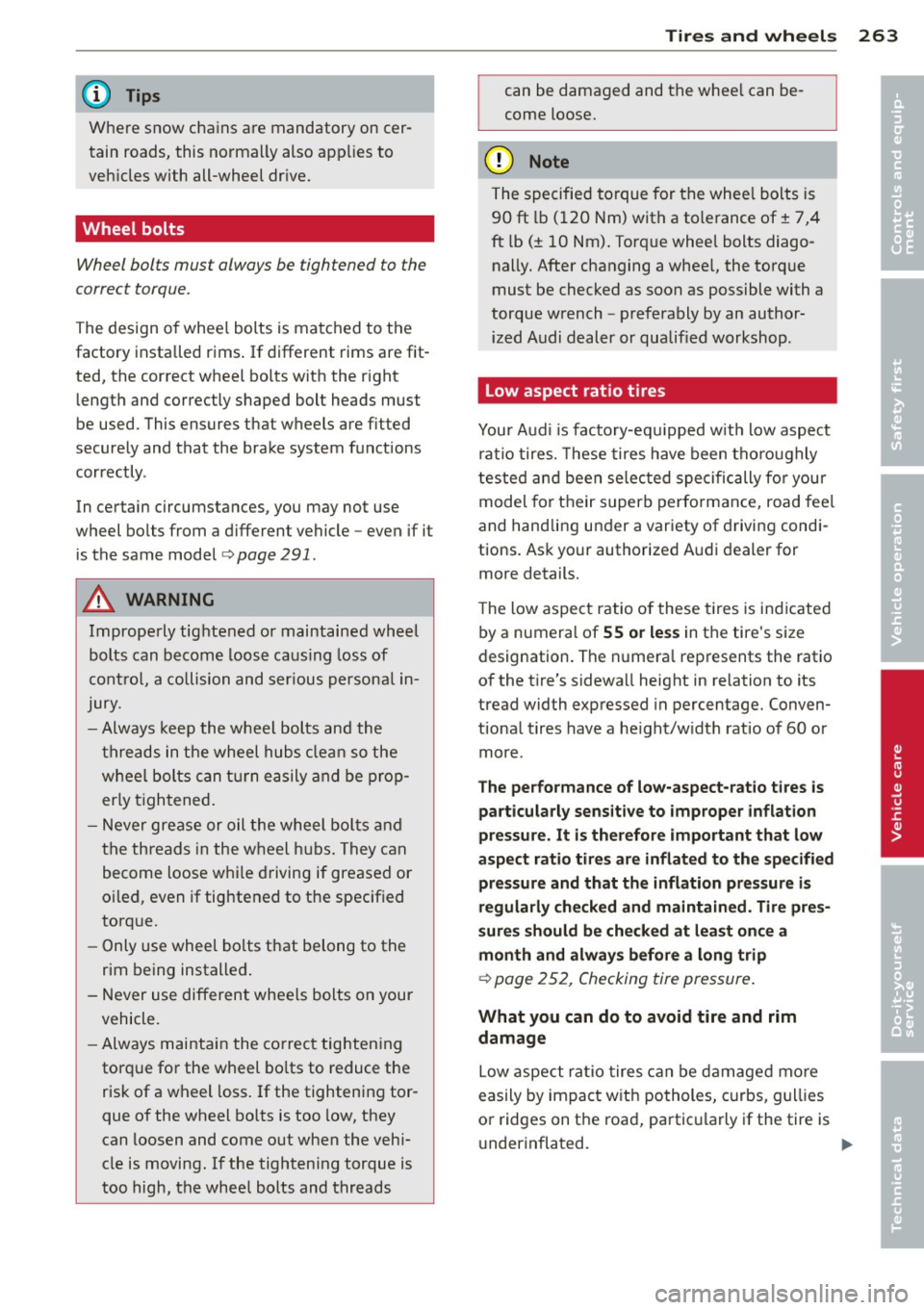
@ Tips
Where snow chains are mandatory oncer
tain roads, this normally also applies to
veh icles with all-wheel dr ive.
Wheel bolts
Wheel bolts must always be tightened to the
correct torque .
The design of whee l bolts is matched to the
factory insta lled rims . If different rims are fit
ted, the correct wheel bolts with the right
length and correctly shaped bolt heads must
be used. This ensures that wheels are f itted
securely and that the brake system functions
correctly .
In certain circumstances, you may not use
wheel bolts from a different vehicle -even if it
is the same model
<=> page 291.
.&_ WARNING
Improperly tightened or maintained wheel
bolts can becom e loose caus ing loss of
cont ro l, a co llision and serious persona l in
Jury .
- Always keep the wheel bolts and the
threads in the wheel hubs clea n so the
w heel bolts can t urn easily and be prop
erly t ightened .
- Never grease or oil the wheel bolts and
the threads in the wheel hubs. They can
become loose while d riving if greased or
oi led, even if tightened to the specif ied
torque.
- Only use whee l bolts that belong to the
rim being installed .
- Never use different whee ls bolts on your
vehicle.
- Always maintain the co rrect tighten ing
torq ue for the wheel bo lts to reduce the
risk of a wheel loss . If the tightening tor
que of the wheel bolts is too low, they
can loosen and come out when the vehi
cle is moving. If the tightening torque is
too high, the whee l bolts and threads
Tire s an d wheel s 263
can be damaged and the whee l can be
come loose.
(D Note
The specified torque for the whee l bolts is
90 ft lb (120 Nm) with a tolerance of± 7,4
ft lb(± 10 Nm) . Torq ue whee l bolts diago
nally. After changing a whee l, the torq ue
must be checked as soon as possible with a
torque wrench -preferably by an author
i zed Audi dealer or qualified workshop.
Low aspect ratio tires
You r Aud i is facto ry-equ ipped w it h low aspect
ra tio tires. These tires have been tho ro ughly
tested and been se lec ted spe cifically for you r
model for their superb perfo rmance, road fee l
and handling under a variety of driving condi
tions. Ask your authorized Audi dealer for
more details .
T he low aspect ratio of these t ires is ind icated
by a numera l of
55 or le ss in the tire's s ize
designation. The numera l represents the ratio
of the t ire's sidewa ll height in relation to its
tread width expressed in percentage. Conven
tiona l tires have a he ight/w idth rat io of 60 or
more .
The performance of low-aspect -ra tio tire s is
particularly sens it iv e to improper inflation
pressure. It is therefore important that low
aspect ratio t ires are inflated to the specified
pre ssure and that the inflation pressur e is
regularly che cked and maintain ed. Tire pre s
s ures should be checked at least on ce a
m onth and alwa ys before a long trip
¢ page 2 52, Checking tire pressure .
What you can do to avoid tire and rim
damage
Low aspect ratio tires can be damage d mo re
easily by impact w ith potholes, curbs, g ull ies
or ridges on t he road, partic ularly if the tire is
u nderinflated.
Ill>-
•
•
Page 266 of 310

264 Tire s and wheel s
In o rder to minimize the occurrence o f impact
damage to the tires of your vehicle, we recom mend that you observe the following precau
tions :
- Always maintain recommended inflation
pressures. Check your tire pressure every
2,000 miles (3,000 km) and add a ir if neces
sary.
- Drive carefu lly on roads with potholes, deep
gullies or ridges. The impact from driving
through or over such obstacles can damage
your tires. Impact with a curb may also cause damage to your tires.
- After any impact, immediately inspect your
tires or have them inspected by the nearest
authorized Aud i dealer . Replace a damaged
t ire as soon as possible .
- In spect your t ires every 2,000 miles (3,000
km) for damage and wear . Damage is not al
ways easy to see. Damage can lead to loss of
air and underinflation, wh ic h could event u
ally cause t ire fail ure.
If yo u be lieve that a
ti re may have been damaged, replace the
tire as soon as possible.
- These tires may wea r more qui ck ly than oth
ers.
- Please a lso remembe r that, whi le these t ires
deliver respons ive handling, they may ride
less comfortably and make more noise than
other choices.
R educed p erformance in winter /cold
sea son conditions
A ll tires are designed for certain purposes .
The low aspect ratio, ultra high performance
tires originally installed on your vehicle are in
tended for max imum dry and wet road per
f ormance and handling . They are not suitable
for cold, snowy or icy weather cond it ions.
If
you dr ive under those circumstances, you
should equip your vehicle with all-season or
winter tires, whi ch offe r better traction under
those cond it ions . We suggest you use the rec
ommended snow or a ll-season tires specifie d
for your vehicle, or their equiva lent .
Refe r to ~
page 261 for mo re deta iled infor
ma tion r egarding w in ter ti res.
Tire pressure
monitoring system
ill General notes
Applies to veh icles: w ith tire pressure monito ring system
Each tire, incl uding the spare (if provided),
sho uld be checked monthly when co ld and in
flated to the inf lat ion pressure recommended
by the veh icle manufacturer on the veh icle
placard or tire inflation pressure label. (If your
vehicle has tires of a d ifferent size than the
s ize indicated on the vehicle placard o r tire in
flat io n pressu re label, you sho uld dete rmine
the p roper t ire infla tion p ressure fo r those
t ir es) .
As an added safety featu re, your ve hicle has
been equipped with a tire pressure mon itoring
system ( TPM S) that illum inates a low ti re
pressure te lltale whe n one or more o f you r
tires is signif icant ly under -inflated . Acco rding
l y, when the low tire pressure te lltale i llumi
nates, you shou ld stop and check your tires as
soon as possib le, and inflate them to the
proper pressure. Driving on a sign ificantly u n
der- inflated t ire causes the tire to overheat
and can lead to tire fa ilure . Under -inflation al
so reduces fuel eff ic iency and tire tread life,
and may affe ct the vehicle 's hand ling and
stopp ing ability.
Please note that the TPMS is not a substitute
for proper tire ma intenance, and it is the d riv
er's respo nsibility to maintain co rrect tire
pressure, even if under -inflation has not
reached the leve l to tr igger illuminat ion of the
T PMS low tire p ressu re tellta le .
You r vehicle has also been equipped with a
T PMS ma lf u nction indicator to ind icate when
the sys tem is not oper ating properly . T he
T PMS ma lfunction indicator is comb ined w ith
the low tire pressure te lltale. Whe n the sys
tem detects a malfunction, the telltale will
flash for approximately one min ute and then
rema in con tinuously i llum inated . T hi s se
quence will continue upon subsequent vehicle
start-ups as long as t he malfunct ion exists . .,.
Page 267 of 310

When the malfunction indicator is illuminat
ed, the system may not be able to detect or
signal low tire pressure as intended. TPMS
malfunctions may occur for a variety of rea
sons, including the installation of replace ment or alternate tires or wheels on the vehi
cle that prevent the TPMS from function ing
properly . Always check the TPMS malfunction
tellta le after replacing one or more tires or
wheels on your vehicle to ensure that the re
placement or alternate tires and wheels allow
the TPMS to continue to function properly.
Tire pressure indicator appears
Applies to vehicles: with tire pressure monitoring system
The tire pressure indicator in the instrument
cluster informs you if the tire pressure is too
low or if there is a system malfunction.
Fig. 201 Display : underinflatio n warning
Fig. 202 Display : Syste m malfun ctio n
Using the ABS sensors, the tire pressure moni
toring system compares the tire tread circum
ference and vibration characteristics of the in
dividual tires . If the pressure decreases in one
or more tires , th is is indicated in the instru
ment cluster with a warning symbol
RE and a
message¢
fig . 201.
The tire pressure monitoring system must be
reset via MMI each time the pressures are ad-
Tires and wheels 265
justed (e.g. when switching between partial
and full load pressure) or after changing or re
plac ing a tire on your vehicle¢
page 266. The
TPMS indicator only monitors the tire pres
sure that you have previously stored. You can
find the recommended tire pressures for your
vehicle on the label on dr iver's side B-pillar
<=:>page 250 .
Tire tread circumference and vibration charac
teristics can change and cause a tire pressure
warning if :
- the tire pressure in one or more tires is too
low,
- the tire has structural damage,
- the tire pressure was changed, wheels rotat-
ed or replaced but the TPMS was not reset
¢page 266 .
Warning symbols
RE Loss of pressure in at least one tire¢.&. .
Check the tire or tires and replace or repair if
necessary. The indicator light
RE in the instru
ment cluster also illuminates
¢ page 12.
Check/correct the pressures of all four tires
and reset TPMS via MMI.
11;;~, ( T ire Pressure Monitoring System) Tire
pressure! System malfunction.
If11NIS, appears after switching the ignition
on or while driving¢
fig. 202 and the indica
tor light
RE in the instrument cluster blinks
for approximately one minute and then stays
on, there is a system malfunction.
Attempt to store the correct tire pressure
¢
page 266 . If the indicator light does not
turn off or if it turns on shortly thereafter, im
mediately drive your vehicle to an authorized
Audi dealer or authorized repair facility to have the malfunction corrected .
A WARNING
-If the tire pressure ind icator appears in
the instrument cluster display, one or
more of your tires is significantly under
inflated. Reduce your speed immediately
and avoid any hard steering or braking
maneuvers. Stop as soon as possib le and .,.
Page 268 of 310

26 6 T ire s and whee ls
check the tires and their pressures. In
flate the tire pressure to the proper pres
sure as indicated on the vehicle's tire
pressure label
c> page 250. Driving on a
significantly under-inflated tire causes
the tire to overheat and can lead to tire
failure. Under-inflation also is likely to impair the vehicle's handling and stop
ping ability.
- T he driver is responsible for ma inta ining
the correct tire pressures. You must check the t ire pressures regular ly .
- Under certain cond itions (such as a spor
ty driving style, winter condit ions or un
paved roads), the pressure monitor indi
cator may be de layed .
- Ask your author ized Audi dealer if r un
flat tires may be used on your vehicle .
Your vehicle regist ration becomes invalid
if yo u use these tires when not permit
ted. Damage to your veh icle or accidents
cou ld also result.
- The tire pressure monitoring system
stops working when there is an ESC/ABS
malfunction .
- Using snow chains may result in a system
malfunction.
- The tire pressure monitoring system on
your Audi was developed using tires with
the "AO" or "RO" identif ication on the
tire sidewall
c> page 257. We recom
mend using these t ires.
Reset tire pressure monitoring system
App lies to vehicles: with tire pressure monito ring system
If the tire pressure is adjusted, wheels are ro
tated or changed, the TPMS must be reset via
MMI.
., Switch on the ignition .
., Se lect in the MMI: !CAR !function button>
(C ar)* s ystems contro l butto n > Se rvicing &
checks > Tire pre ssure mon itoring > Store
tire pr essures> Ye s, store n ow .
(D Tips
Do not store the tire pressure if there are
snow cha ins on the tire .
Page 269 of 310
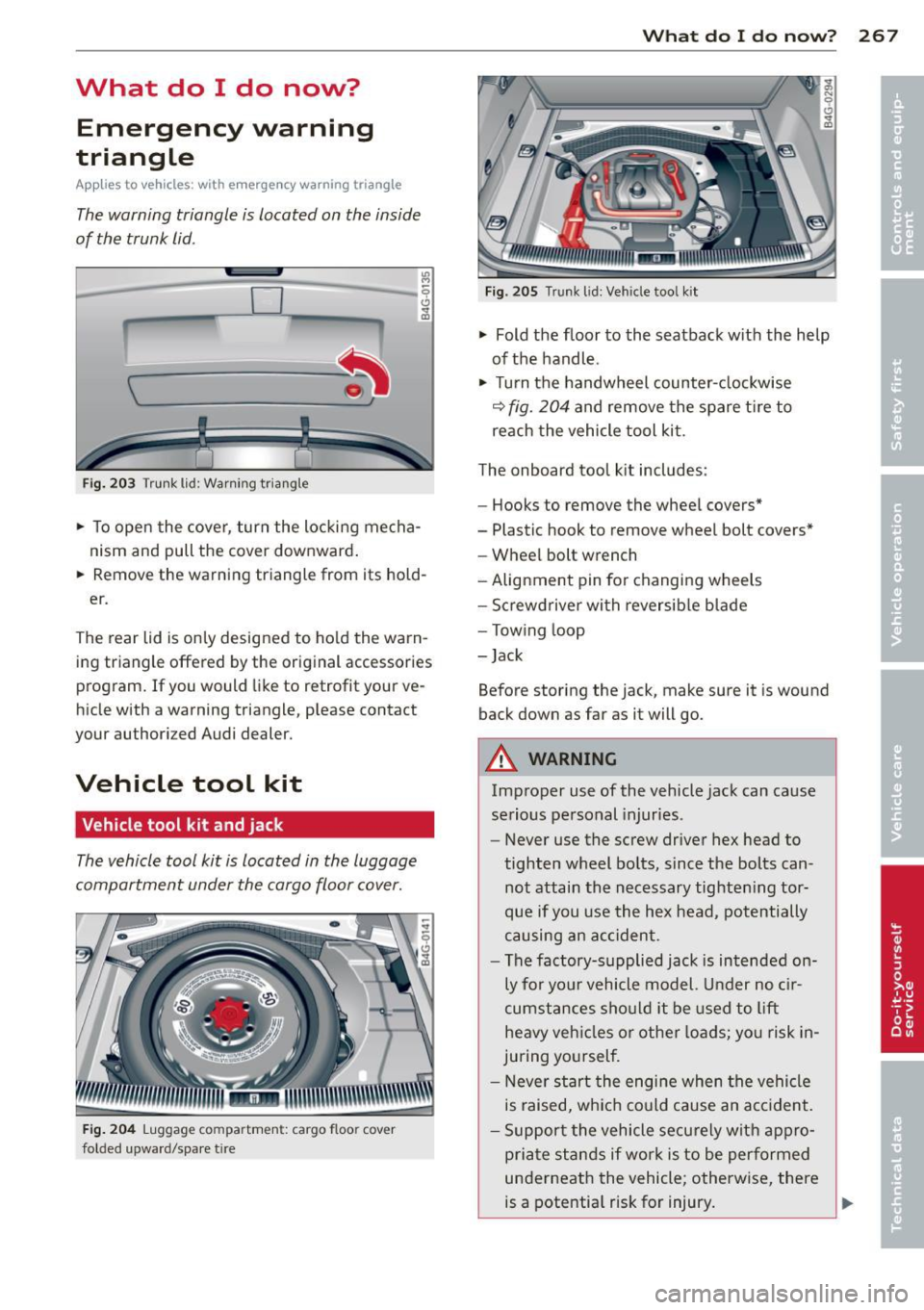
What do I do now? Emergency warning
triangle
App lies to vehicles: with emerge ncy warning triangle
The warning triangle is located on the inside
of the trunk lid .
"' M ~
D -~ .. m
!I l
Fig. 203 Trun k lid: Warn ing triang le
.,. To open the cover, turn the locking mecha
nism and pull the cover downward .
.,. Remove the warning triangle from its hold
er.
The rear lid is only designed to ho ld the warn
ing triangle offered by the original accessories
program. If you would like to retrofit your ve
hicle with a warning triangle, p lease contact
your authorized Audi dealer.
Vehicle tool kit
Vehicle tool kit and jack
The vehicle tool kit is located in the luggage
compartment under the cargo floor cover.
F ig . 204 Luggage compa rtment: cargo floo r cover
folded upward/spa re tire
What do I d o now ? 267
Fig. 20 5 Trunk lid: Veh icle too l kit
.,. Fold the floor to the seatback with the help
of the handle .
.,. Turn the handwheel counter- clockwise
q fig. 204 and remove the spare t ire to
reach the vehicle tool kit.
T he onboard tool k it includes:
- Hooks to remove the whee l covers*
- Plastic hook to remove wheel bolt covers*
- Wheel bolt wrench
-Alignment pin for changing wheels
- Screwdriver with reversib le blade
- Tow ing loop
-Jack
Before storing the jack, make sure it is wound
back down as far as it will go.
A WARNING
Im proper use of the vehicle jack can cause
serious personal injuries.
- Never use the screw driver hex head to
tighten w heel bolts, since the bolts can
not attain the necessary tighten ing tor
que if you use the hex head, potentially
causing an ac cident.
- The factory-supplied jack is intended on
ly for yo ur vehicle model. Under no c ir
cumstances sho uld it be used to lift
heavy ve hicles o r other loads; yo u risk in
juring yo urself.
- Never start the engine when the vehicle
is raised, wh ich co uld cause an acc ident.
- Support the vehicle secu rely with appro
pria te stands if wor k is to be per formed
underneath the vehicle; otherwise, there
is a potentia l risk for injury.
Page 270 of 310
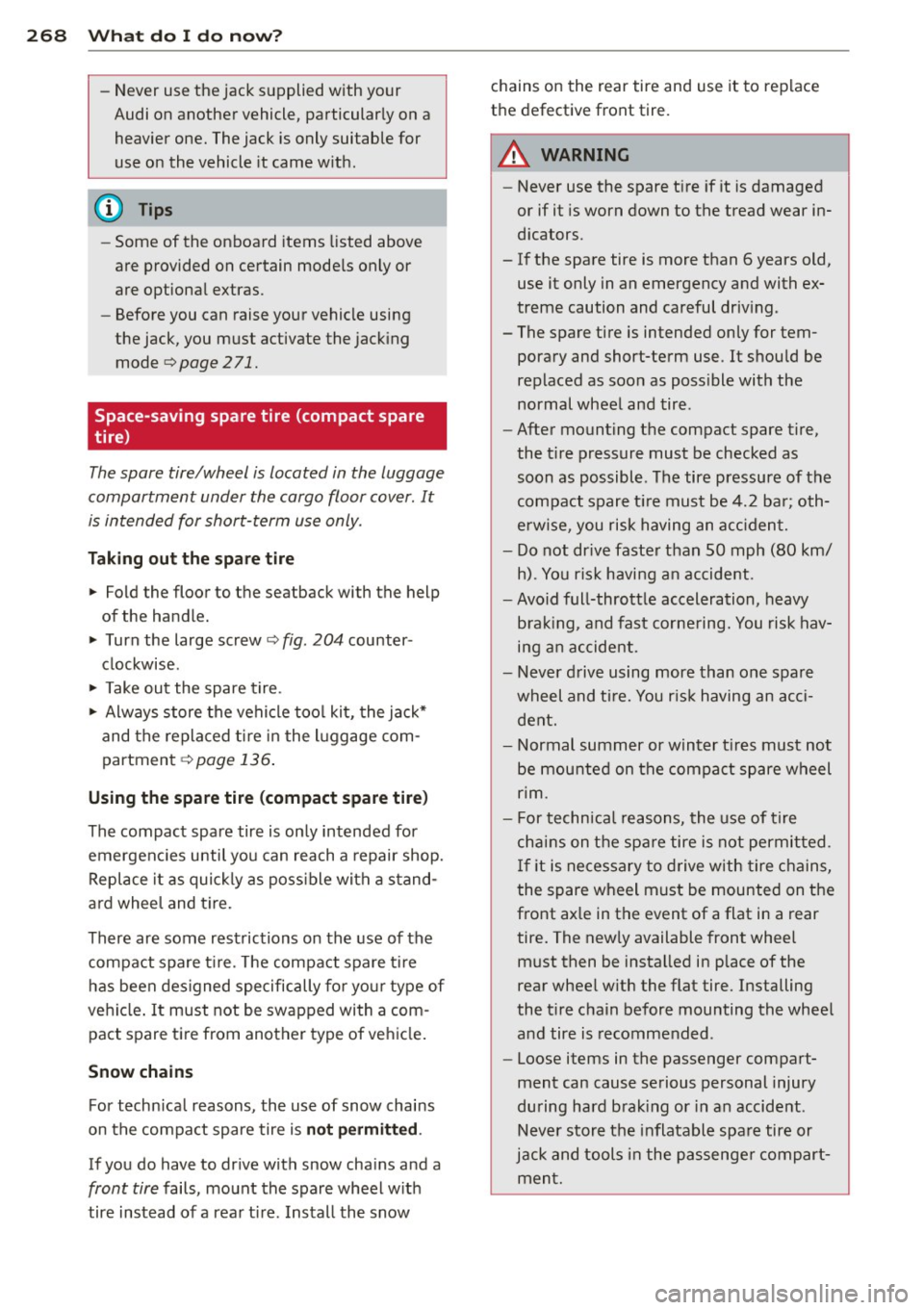
268 What do I do no w?
-Never use the jack s upplied with your
Audi on another vehicle, particularly on a
heavier one. The jack is only suitable for
use on the vehicle it came w ith.
- Some of the on board items listed above
are provided on certain mode ls only or
are optiona l extras.
- Before you can raise your vehicle using
the jack, you must activate the jack ing
mode
Q page 271.
Space-saving spare tire (compact spare
tire)
The spare tire/wheel is located in the luggage
compartment under the cargo floor cover. It
is intended for short-term use only.
Taking out the sp are tire
,. Fold the floor to the seatback with the help
of the handle.
,. Turn the large screw~
fig. 204 counter
clockwise.
,. Take out the spare tire .
,. Always store the vehicle too l kit, the jack*
and the replaced t ire in the l uggage com
partment
Q page 136.
Using the spare tire (compact spare tir e)
The compact spare tire is only intended for
emergenc ies until you can reach a repair shop.
Replace it as quick ly as poss ible with a s tand
a rd whee l and tire.
There are some restrictions on the use of the
compact spare t ire. The compact spare t ire
has been des igned specifically fo r yo ur type of
ve hicle . It must not be swapped with a com
pact spare ti re from another type of ve hicle .
Snow chains
For technica l reasons, the use of snow chains
on the compa ct spare tire is
not p ermitt ed .
If you do have to dr ive with snow cha in s and a
front tire fails , mo unt the spare wheel w ith
tire instead of a rea r tir e . I nstall the snow chains on the rear tire and use it to rep
lace
the defective front tire.
A WARNING
-- Never use the spare t ire if it is damaged
or if it is worn down to the tread wear in
d icat ors.
- I f the spare tire is more than 6 years old,
use it only in an emergency and with ex
treme caution and careful driv ing.
- The spare tire is intended only for tem porary and sh ort-term use . It s hou ld be
replaced as soo n as poss ible with the
normal wheel and tire.
- After mount ing t he compact spare t ire,
the t ire pressure must be checked as
soon as possible . The tire pressure of the
compact spa re t ire must be
4. 2 ba r; oth
erwi se, you risk having an a cc iden t.
- Do not dr ive faste r th an
50 mph (80 km/
h). Yo u ris k havi ng a n accident.
- Avoid full-throttle acceleration, heavy
b rak ing, and fast corne ring . You risk hav
ing ('In accide nt.
- N ever d rive using more than one s pare
wheel and ti re. You r is k having an acci
den t.
- Normal summer or winter t ires must not
be mounted on the compa ct spare wheel
r im .
- F or technica l reasons, the use of tire
ch ain s on t he sp are tire is not permitted.
If it is ne cessary to drive with tir e c hains,
the spare wheel must be mounted on the
f ront ax le in the event of a flat in a rear
tire. The new ly available front whee l
m ust then be insta lled in place of the
rear whee l w ith the flat tire. Installing
the t ire chain before mounting the whee l
a nd tire is recommended .
- Loose items in the passenger compart
ment can cause se rious personal injury
du ring hard b rak ing or in an accident.
Never store t he i nflatable spa re tire or
jack and tool s in the passenge r compart
men t.